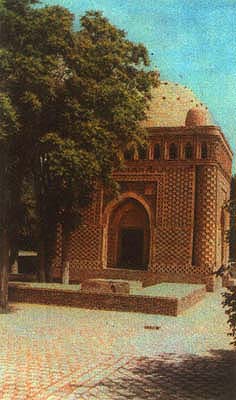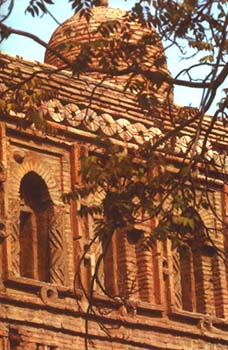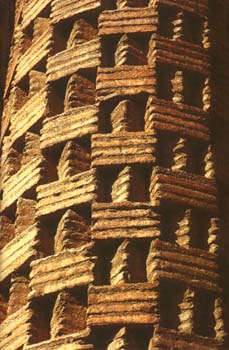Samani
Park
 Approaching
the Ark by road from any of the hotels you pass a pair of 16th century
kosh madrasas, facing each other nonchalantly across Ulitsa Sverdlova,
near the east end of Samani (ex-Kirov) park. On the left facing east, the
Abdullah Khan madrasa (1588-90) was architecturally daring for its time
because the cells radiating off its north and west iwans cause the overall
shape to depart from the standard madrasa rectangle. The Modari Khan madrasa
opposite was dedicated by Abdullah Khan to his mother in 1567 (974 in the
Islamic calendar), according to a verse in majolica over the main entrance.
In any other city these buildings would be the object of huge curatorial
fuss. In Bukhara two other kosh ensembles outshine them. They are padlocked,
unrestored and hardly visited.
Approaching
the Ark by road from any of the hotels you pass a pair of 16th century
kosh madrasas, facing each other nonchalantly across Ulitsa Sverdlova,
near the east end of Samani (ex-Kirov) park. On the left facing east, the
Abdullah Khan madrasa (1588-90) was architecturally daring for its time
because the cells radiating off its north and west iwans cause the overall
shape to depart from the standard madrasa rectangle. The Modari Khan madrasa
opposite was dedicated by Abdullah Khan to his mother in 1567 (974 in the
Islamic calendar), according to a verse in majolica over the main entrance.
In any other city these buildings would be the object of huge curatorial
fuss. In Bukhara two other kosh ensembles outshine them. They are padlocked,
unrestored and hardly visited.
Ismail Samani Mausoleum
 When
Samani park was laid out in the 1930s, a Russian archaeologist called Shishkin
rediscovered an architectural gem that had languished under two metres
of sediment for the 400 years of the khanate. The Ismail Samani mausoleum
is one of the world's oldest monuments to famous Muslims. Samani built
it for his father and grandson in 907, and was later buried here himself.
It is unique in bearing traces of pre-Islamic, Sogdian culture while pioneering
architectural and decorative techniques that were to be used for the next
five centuries.
When
Samani park was laid out in the 1930s, a Russian archaeologist called Shishkin
rediscovered an architectural gem that had languished under two metres
of sediment for the 400 years of the khanate. The Ismail Samani mausoleum
is one of the world's oldest monuments to famous Muslims. Samani built
it for his father and grandson in 907, and was later buried here himself.
It is unique in bearing traces of pre-Islamic, Sogdian culture while pioneering
architectural and decorative techniques that were to be used for the next
five centuries.
Its cubic base, representing the earth, supports a heavenly
hemisphere to form a Sogdian metaphor for the universe. Built before ceramics
came to Central Asia, the mausoleum consists entirely of clay bricks bound
with egg yolk and camels' milk-but no ordinary bricklayer was at work here.
In Geoffrey Moorhouse's words, 'someone obsessed with the possibilities
inherent in brick had been trying to push variety to its limits.' The bricks
are arranged in 18 different two- and three-dimensional patterns which
make the massive walls look featherweight, creating in some places 'the
texture of elaborate basketwork', in others 'a lattice through which
an evening breeze might cool the summer heat inside'.
 The
lower part of the mausoleum has survived in all its intricacy for a thousand
years. Shishkin restored the dome and corner cupolas in the 1930s with
egg-and-milk bricks which are virtually indistinguishable from the originals.
He also cleared away the sediment to reveal the building's full height,
and moved to another cemetery the graves which had crowded around when
this was a fashionable place to be buried. Now you can | walk right round
the mausoleum. If you do three circuits and make a wish, the wish will
come true.
The
lower part of the mausoleum has survived in all its intricacy for a thousand
years. Shishkin restored the dome and corner cupolas in the 1930s with
egg-and-milk bricks which are virtually indistinguishable from the originals.
He also cleared away the sediment to reveal the building's full height,
and moved to another cemetery the graves which had crowded around when
this was a fashionable place to be buried. Now you can | walk right round
the mausoleum. If you do three circuits and make a wish, the wish will
come true.
[back]
